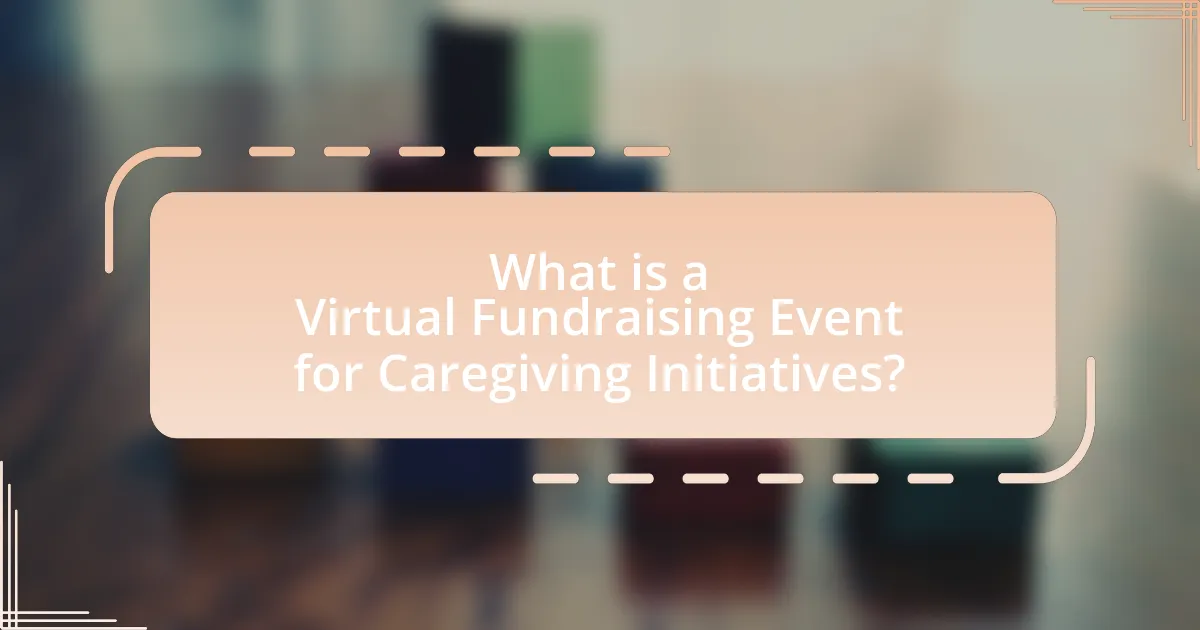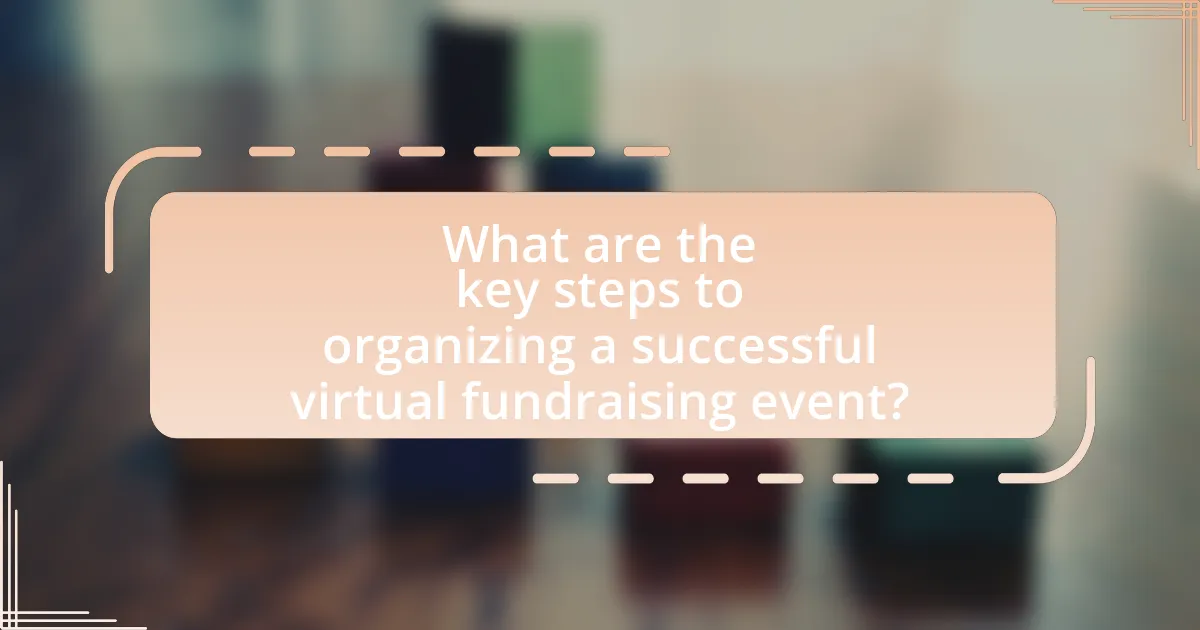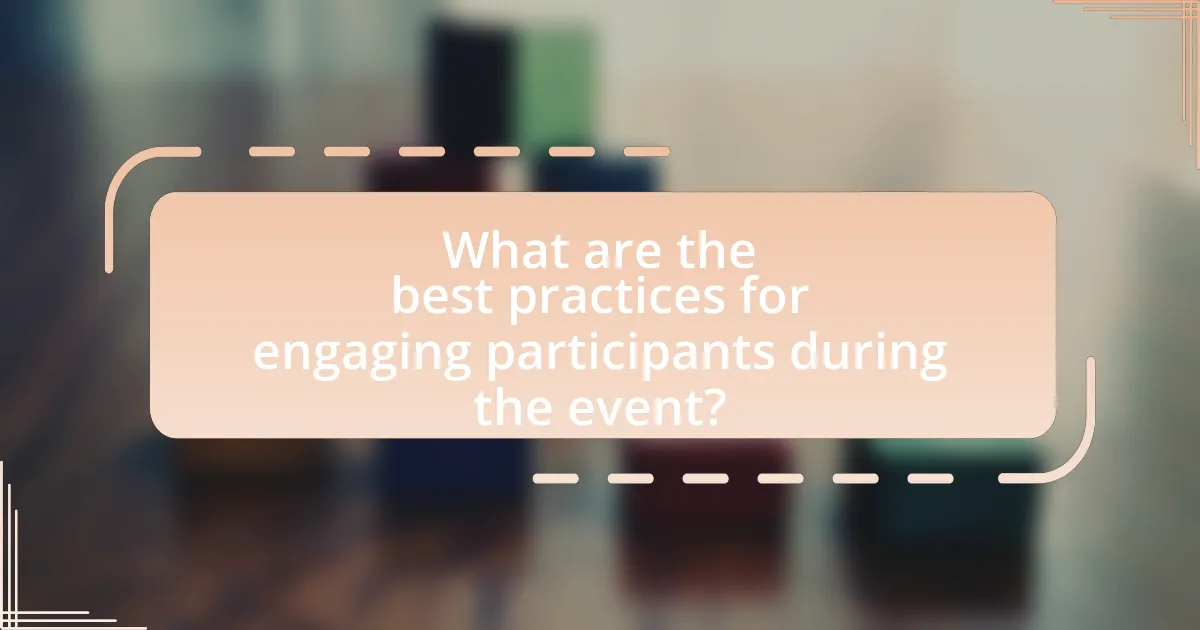A Virtual Fundraising Event for Caregiving Initiatives is an online event aimed at raising funds and awareness for caregiving programs. This article outlines the differences between virtual and traditional fundraising, essential technologies for hosting such events, and strategies to enhance donor engagement. It emphasizes the importance of caregiving initiatives, the specific needs they address, and how fundraising supports their sustainability. Additionally, the article provides practical steps for organizing a successful virtual event, including goal setting, promotion, participant engagement, and post-event follow-up, while also addressing common challenges and solutions.

What is a Virtual Fundraising Event for Caregiving Initiatives?
A Virtual Fundraising Event for Caregiving Initiatives is an online gathering designed to raise funds and awareness for caregiving programs and services. These events leverage digital platforms to connect participants, allowing them to contribute financially while engaging in activities such as webinars, auctions, or live-streamed performances. According to a report by the Nonprofit Research Collaborative, virtual fundraising has seen a significant increase, with 70% of nonprofits reporting that they utilized online events to raise funds during the pandemic, highlighting the effectiveness of this approach in reaching broader audiences and generating support for caregiving initiatives.
How does a virtual fundraising event differ from traditional fundraising?
A virtual fundraising event differs from traditional fundraising primarily in its format and accessibility. Virtual fundraising events utilize online platforms to engage participants, allowing for broader geographic reach and participation without the constraints of physical location. For instance, a study by Nonprofit Tech for Good in 2021 indicated that 70% of nonprofits reported increased engagement through virtual events compared to in-person gatherings. This shift enables organizations to connect with a larger audience, reduce overhead costs associated with venue rentals, and leverage digital tools for real-time interaction and fundraising.
What technologies are essential for hosting a virtual fundraising event?
Essential technologies for hosting a virtual fundraising event include video conferencing platforms, online payment processing systems, and event management software. Video conferencing platforms, such as Zoom or Microsoft Teams, facilitate real-time interaction and engagement with participants. Online payment processing systems, like PayPal or Stripe, enable secure transactions for donations. Event management software, such as Eventbrite or Hopin, assists in organizing the event, managing registrations, and providing analytics. These technologies collectively enhance the experience for both organizers and attendees, ensuring a successful fundraising effort.
How can virtual events enhance engagement with donors?
Virtual events enhance engagement with donors by providing interactive platforms that facilitate real-time communication and connection. These events allow organizations to showcase their mission and impact through engaging presentations, live Q&A sessions, and personal stories, which can significantly increase donor interest and emotional investment. According to a study by the Nonprofit Research Collaborative, organizations that utilized virtual events reported a 30% increase in donor engagement compared to traditional fundraising methods. This increase is attributed to the accessibility of virtual events, allowing donors to participate from anywhere, thus broadening the audience reach and fostering a sense of community among supporters.
Why are caregiving initiatives important for fundraising?
Caregiving initiatives are important for fundraising because they address critical needs within communities, fostering support for vulnerable populations. These initiatives often highlight the emotional and financial burdens faced by caregivers, which can motivate donors to contribute. For instance, studies show that 66% of caregivers report financial strain, making targeted fundraising efforts essential to alleviate these pressures and enhance support services. By raising funds, organizations can provide resources, training, and respite care, ultimately improving the quality of life for both caregivers and those they support.
What specific needs do caregiving initiatives address?
Caregiving initiatives address the specific needs of support for caregivers, access to resources, and improved quality of care for recipients. These initiatives provide emotional support, training, and respite care to alleviate caregiver stress, which is crucial as studies show that 40-70% of family caregivers experience significant emotional distress. Additionally, they facilitate access to medical and financial resources, ensuring caregivers can effectively manage their responsibilities. By addressing these needs, caregiving initiatives enhance the overall well-being of both caregivers and those receiving care, ultimately leading to better health outcomes.
How can fundraising support the sustainability of caregiving initiatives?
Fundraising can support the sustainability of caregiving initiatives by providing essential financial resources needed for ongoing operations and program development. These funds can be allocated to training caregivers, enhancing service delivery, and expanding outreach efforts, which are critical for maintaining high-quality care. For instance, a study by the National Alliance for Caregiving indicates that adequate funding directly correlates with improved caregiver support services, leading to better outcomes for both caregivers and those receiving care.

What are the key steps to organizing a successful virtual fundraising event?
The key steps to organizing a successful virtual fundraising event include defining clear goals, selecting the right platform, promoting the event effectively, engaging participants during the event, and following up afterward. Defining clear goals ensures that the fundraising target and purpose are established, which guides all planning efforts. Selecting the right platform, such as Zoom or Facebook Live, is crucial for facilitating interaction and donations. Effective promotion through social media, email campaigns, and partnerships increases visibility and attendance. Engaging participants with interactive elements, such as live auctions or Q&A sessions, enhances the experience and encourages donations. Finally, following up with participants through thank-you messages and updates on the impact of their contributions fosters ongoing support and builds community.
How do you set clear goals for the fundraising event?
To set clear goals for a fundraising event, first define the specific financial target you aim to achieve, such as raising $10,000 for caregiving initiatives. This target should be based on a thorough assessment of the needs of the initiative and the potential donor base. Additionally, establish measurable objectives, such as the number of attendees, the amount raised per attendee, and the engagement level during the event. Research indicates that events with clearly defined goals are 30% more likely to meet or exceed their fundraising targets, as outlined in the “Fundraising Effectiveness Project” by the Association of Fundraising Professionals.
What factors should be considered when determining fundraising targets?
When determining fundraising targets, organizations should consider their financial goals, the costs associated with the event, and the potential donor base. Financial goals define the minimum amount needed to support caregiving initiatives, while understanding event costs ensures that targets are realistic and achievable. Additionally, analyzing the potential donor base, including their capacity and willingness to give, helps in setting appropriate targets. For instance, a study by the Association of Fundraising Professionals indicates that organizations that align their targets with donor demographics tend to raise 30% more than those that do not.
How can you measure the success of your fundraising goals?
You can measure the success of your fundraising goals by evaluating the total amount of funds raised against your target amount. This involves tracking donations received during the fundraising campaign and comparing them to the predefined financial objectives. For instance, if your goal was to raise $10,000 and you raised $12,000, you exceeded your target by 20%. Additionally, analyzing donor engagement metrics, such as the number of unique donors and the average donation size, provides insights into the campaign’s reach and effectiveness. These metrics help assess not only financial success but also community involvement and support for the caregiving initiatives.
What strategies can be employed to promote the event effectively?
To promote a virtual fundraising event for caregiving initiatives effectively, utilize targeted social media campaigns. These campaigns should leverage platforms like Facebook, Instagram, and Twitter to reach specific demographics interested in caregiving and philanthropy. Research indicates that 73% of marketers believe that their efforts through social media marketing have been “somewhat effective” or “very effective” for their business (Buffer, 2021). Additionally, engaging influencers within the caregiving community can amplify reach and credibility, as their endorsements can lead to increased participation. Email marketing is also crucial; sending personalized invitations and reminders can enhance attendance rates, with studies showing that segmented email campaigns can achieve up to 14.31% higher open rates (Mailchimp, 2021). Lastly, creating shareable content, such as videos and infographics that highlight the cause, can encourage attendees to promote the event within their networks, further expanding its visibility.
Which platforms are best for promoting a virtual fundraising event?
The best platforms for promoting a virtual fundraising event include social media networks like Facebook, Instagram, and Twitter, as well as crowdfunding sites such as GoFundMe and Kickstarter. Social media allows for targeted advertising and community engagement, with Facebook reporting over 2.8 billion monthly active users, making it ideal for reaching a wide audience. Crowdfunding platforms provide built-in audiences specifically looking to support fundraising efforts, with GoFundMe alone raising over $9 billion for various causes since its inception. These platforms effectively enhance visibility and engagement for virtual fundraising initiatives.
How can social media be leveraged to increase participation?
Social media can be leveraged to increase participation by creating engaging content that encourages sharing and interaction among users. Platforms like Facebook, Instagram, and Twitter allow organizations to reach a wider audience through targeted advertising and organic posts, which can significantly boost visibility. For instance, a study by the Pew Research Center found that 69% of adults in the U.S. use social media, indicating a vast potential audience for outreach efforts. Additionally, using features such as live streaming, polls, and event pages can foster community engagement and prompt users to participate actively in fundraising initiatives.

What are the best practices for engaging participants during the event?
To effectively engage participants during a virtual fundraising event for caregiving initiatives, utilize interactive elements such as live polls, Q&A sessions, and breakout rooms. These strategies foster active participation and maintain interest throughout the event. Research indicates that events incorporating interactive features can increase participant engagement by up to 70%, as they encourage attendees to contribute and connect with the content and each other. Additionally, leveraging storytelling techniques to share impactful caregiving experiences can resonate emotionally with participants, enhancing their connection to the cause and motivating them to contribute.
How can you create an interactive experience for attendees?
To create an interactive experience for attendees, utilize live polls and Q&A sessions during the virtual fundraising event. These tools encourage real-time participation, allowing attendees to voice their opinions and ask questions, which fosters engagement. Research indicates that events incorporating interactive elements can increase attendee satisfaction by up to 70%, as they feel more connected to the content and each other. Additionally, integrating breakout rooms for small group discussions can enhance interaction, enabling attendees to share experiences and ideas, further enriching the overall experience.
What types of activities can enhance participant engagement?
Interactive activities such as live polls, Q&A sessions, and breakout discussions can significantly enhance participant engagement in virtual fundraising events. These activities encourage real-time participation and foster a sense of community among attendees. For instance, a study by the Virtual Event Institute found that events incorporating interactive elements saw a 70% increase in participant satisfaction and engagement levels. Additionally, gamification techniques, such as quizzes or challenges related to caregiving initiatives, can motivate participants to engage more deeply, as evidenced by research from the Journal of Nonprofit & Public Sector Marketing, which highlights that gamified experiences can lead to higher retention rates and increased donations.
How can storytelling be used to connect with the audience?
Storytelling can be used to connect with the audience by creating emotional resonance and relatability through shared experiences. When narratives highlight personal journeys or challenges faced by caregivers, they foster empathy and understanding among the audience. Research indicates that stories activate the brain’s mirror neurons, which enhance emotional engagement and connection. For instance, a study published in the journal “Neuroscience & Biobehavioral Reviews” found that storytelling can increase audience engagement by up to 30%, making it a powerful tool for fundraising initiatives. By weaving in real-life examples and testimonials, storytellers can effectively draw the audience into the mission, encouraging support and participation in caregiving initiatives.
What follow-up actions are necessary after the event?
After the event, it is necessary to send thank-you messages to all participants, donors, and volunteers. This action acknowledges their contributions and fosters goodwill, which can lead to future support. Additionally, organizers should analyze the event’s performance by reviewing metrics such as attendance, funds raised, and engagement levels. This analysis helps identify strengths and areas for improvement in future events. Finally, sharing the event’s outcomes and impact with stakeholders through reports or newsletters reinforces transparency and accountability, encouraging ongoing support for caregiving initiatives.
How should you thank participants and donors post-event?
To thank participants and donors post-event, send personalized thank-you messages that express genuine appreciation for their support. Personalized communication enhances the emotional connection and acknowledges the specific contributions made by each individual or organization. Research indicates that personalized thank-you notes can increase donor retention rates by up to 50%, demonstrating the effectiveness of this approach in fostering long-term relationships.
What methods can be used to report on the event’s success?
To report on the event’s success, organizers can utilize methods such as participant surveys, financial analysis, and social media engagement metrics. Participant surveys provide direct feedback on attendee satisfaction and areas for improvement, which can be quantified to assess overall success. Financial analysis involves comparing the funds raised against the event’s goals and previous events, offering a clear measure of financial success. Social media engagement metrics, including shares, likes, and comments, reflect the event’s reach and impact, indicating how well the event resonated with the audience. These methods collectively provide a comprehensive view of the event’s effectiveness in achieving its objectives.
What are some common challenges in organizing virtual fundraising events?
Common challenges in organizing virtual fundraising events include technology issues, participant engagement, and fundraising goals. Technology issues often arise from unreliable internet connections or unfamiliarity with virtual platforms, which can hinder the event’s execution. Participant engagement is another challenge, as maintaining interest and interaction in a virtual setting can be difficult compared to in-person events. Additionally, achieving fundraising goals can be more challenging online, as donors may feel less compelled to contribute without the personal connection of a physical event. These challenges highlight the need for careful planning and execution to ensure the success of virtual fundraising initiatives.
How can technical issues be mitigated during the event?
Technical issues can be mitigated during the event by implementing a robust technical support system. This includes having dedicated IT personnel available to troubleshoot problems in real-time, ensuring all software and hardware are tested prior to the event, and providing participants with clear instructions on how to access and use the technology. Research indicates that 70% of technical issues can be resolved quickly with on-site support, which minimizes disruptions and enhances the overall experience for attendees.
What strategies can help maintain donor interest over time?
To maintain donor interest over time, organizations should implement regular communication, personalized engagement, and transparent reporting on the impact of donations. Regular communication, such as newsletters or updates, keeps donors informed about ongoing projects and initiatives, fostering a sense of connection. Personalized engagement, including tailored messages and recognition of individual contributions, enhances the donor experience and strengthens relationships. Transparent reporting, which includes sharing specific outcomes and success stories related to their contributions, builds trust and demonstrates accountability. Research indicates that organizations that maintain consistent and meaningful interactions with donors see a 20% increase in donor retention rates, highlighting the effectiveness of these strategies.
What practical tips can ensure a successful virtual fundraising event?
To ensure a successful virtual fundraising event, it is essential to engage participants through interactive elements, clear communication, and effective promotion. Engaging participants can be achieved by incorporating live polls, Q&A sessions, and breakout rooms, which have been shown to increase attendee involvement and satisfaction. Clear communication involves providing detailed information about the event’s purpose, schedule, and how funds will be used, which builds trust and encourages donations. Effective promotion through social media, email campaigns, and partnerships can significantly increase visibility; for instance, events that utilize multiple channels for promotion see up to 50% higher attendance rates.